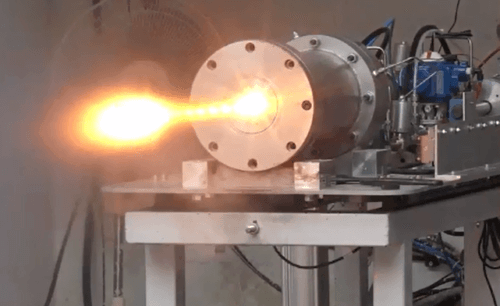This is what New Rocket CEO Ilan Harel says in an interview with the Hidan website. The startup company has developed a new type of space fuel that can replace hydrazine not only in orbit stabilization like hydrazine but also for high-energy applications of satellite orbit changes and rocket upper stages

New-Ranket's gel engine: as strong as solid fuel and as controllable as hydrazine, so that it can be used in applications that require immediate engine on and off, but also has strong acceleration that can help direct the upper stages of missiles. This is what the CEO of the company Ilan Harel says in an interview with the Hidan website.
The startup company NewRocket is a graduate of Incubit Ventures, the technology incubator of Elbit Systems, which invests in early-stage deep-tech companies.
As mentioned, New-Rocket develops advanced rocket engines based on the use of gel instead of liquid fuel or solid fuel. The engine combines the advantages of power, controllability and environmental friendliness (relative to alternatives), while complying with the strictest regulations. New-Rocket's solution is suitable for satellites of all sizes as well as for other applications in the field of space, and enables maneuverability and high-energy orbit transitions. The engine runs on gel-based fuel, providing clean propulsion without compromising on high performance and full thrust control.
"The space community knows that hydrazine is on the way out." Harel explains. "In Europe, they even formulated a directive that would prohibit the storage and use of hydrazine due to its toxicity, which could harm people in the vicinity in the event of a refueling malfunction, to the chagrin of the heads of the aviation and space industry on the continent. NASA is preparing a road map for green propulsion, and even our Indian friends are talking about green propulsion. Undoubtedly the world is on its way there. We will be ready."

"How come big companies didn't think of this?
Harel: "Some companies have started the way to develop a replacement for hydrazine, but they all concentrate on the side of the low impulses - and we are going in the direction of the high impulses and high energy, for example when changing routes. Here our engines will be able to serve the mission in the best way."
"Our development is based on a patent developed by Prof. Benny Natan at the Technion Rocket Propulsion Center and this patent is licensed to the New Rocket company. We work in full cooperation with the Technion, even our facilities are in the Technion, the Technion are even shareholders in the company and full partners."
What is the gel used by your engines?
Harel: "The base of the gel is normal fuel - kerosene, but it is combined with certain ingredients that we cannot specify that turn the fuel into a gel and through those ingredients the fuel actually knows how to enjoy the advantages of solid fuel on the one hand that it can be stored without fear, and on the other hand in an instant As it passes through the set of dedicated injectors we developed, it acquires liquid properties. In this way he gets the full controllability of unlimited activation and deactivation. We are putting in place a solution that benefits all worlds."
"There are engines that know how to turn on and off instantly and are used for propulsion, both hydrazine-based engines and electric engines. There are engines that know how to provide high energy and there are engines that know how to work with environmentally friendly materials, we give it all together. This combination is what makes us special."
"Actually, the options to date are hydrazine engines with low thrust or solid fuel engines with high thrust. These engines are mainly used to give thrust to spacecraft taking off. We have seen them, for example, attached to the space shuttles and they will also be used in the Orion program. The problem is that they have no control ability - they are like a match. You light it once and it continues to burn until the fuel runs out."
In a press release accompanying the announcement of the company, it was stated that New-Rocket recently signed the first contracts with leading corporations in the field of the space and aviation industry, and is already carrying out projects in the amount of over 6 million dollars in order to expand penetration into the global market, the company raised one million dollars, from a fundraising round which is still ongoing, from the British investment company Consensus Business Group (CBG) of investor Vincent Tchenguiz. CBG manages a global investment portfolio of 600 million dollars.
How many employees do you have and what are the company's goals?
"The project employs close to 20 people, some of them scientists, some materials people and some mechanics people. Some are permanent and some are employed by project. We are currently in the development phase. My immediate goals as CEO are to expand investments and carry out the first projects, and the other goal is to team up with a strategic partner from the space world and integrate our engines into their product.
"The investment will be used by New-Rocket to realize its growth strategy, to accelerate the development of the engine and introduce our propulsion solutions to the civil global aviation and space market. "Companies in the new space field are launching arrays of thousands of satellites. New-Rocket's propulsion solution will enable a more efficient deployment of satellites in orbit as well as performing orbit changes with maximum efficiency."
Recently, New-Rocket performed a proof of feasibility (POC) for additional and central applications in the world of aviation and energy, not necessarily in space.
More of the topic in Hayadan:
- An interview with Aryeh Halzband, the founder of the Israeli start-up for servicing satellites in space
- ExoTerra presents - the engine that will bring small satellites to an asteroid
- An American missile destroyed the toxic satellite, but caused many pieces of space and fear of legitimacy for the Chinese to develop anti-satellite weapons
